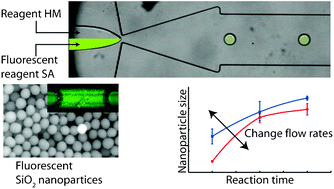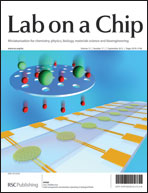Controlled synthesis of fluorescent silica nanoparticles inside microfluidic droplets†
Abstract
We study the droplet-based synthesis of fluorescent silica nanoparticles (50–350 nm size) in a microfluidic chip. Fluorescein-isothiocyanate (FITC) dye is first chemically linked to aminopropyl triethoxysilane (APTES) in ethanol and this reaction product is subsequently mixed with tetraethyl orthosilicate (TEOS) to yield a fluorescent silicon alkoxide precursor solution. The latter reacts with an aqueous ethanol–ammonia hydrolysing mixture inside droplets, forming fluorescent silica nanoparticles. The droplets are obtained by pinching-off side-by-side flowing streams of alkoxide solution/hydrolysing mixture on a microfluidic chip using a Fluorinert oil continuous phase flow. Synthesis in droplets leads to a faster reaction and allows drastically improved nanoparticle size uniformity (down to 3% relative standard deviation for 350 nm size particles) when compared to conventional bulk synthesis methods, thanks to the precise control of reagent concentrations and reaction times offered by the microfluidic format. Incorporating FITC inside silica nanoparticles using our method leads to reduced dye leakage and increases the dye's stability, as evidenced by a reduced photochemical bleaching compared to a pure FITC solution.


 Please wait while we load your content...
Please wait while we load your content...